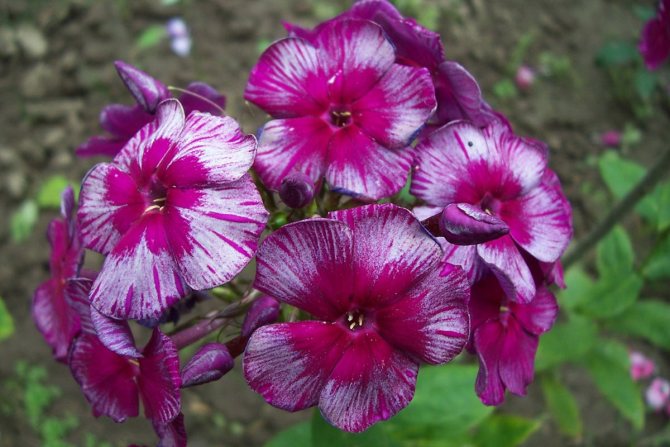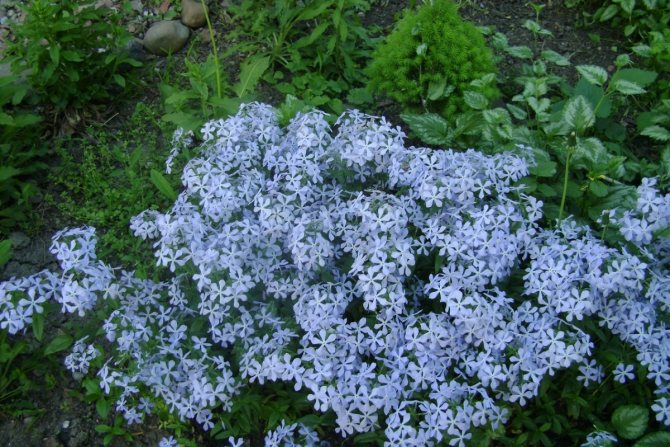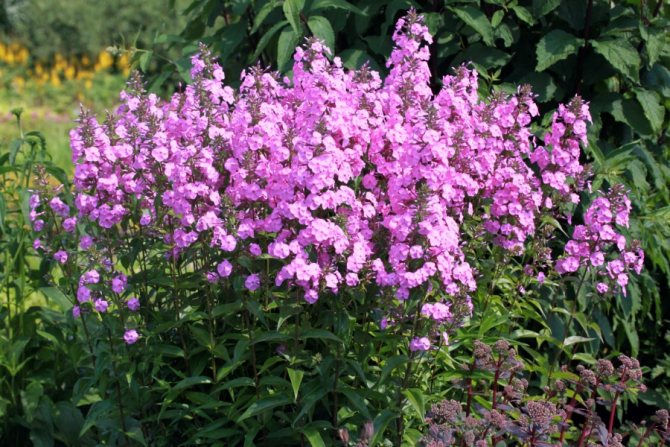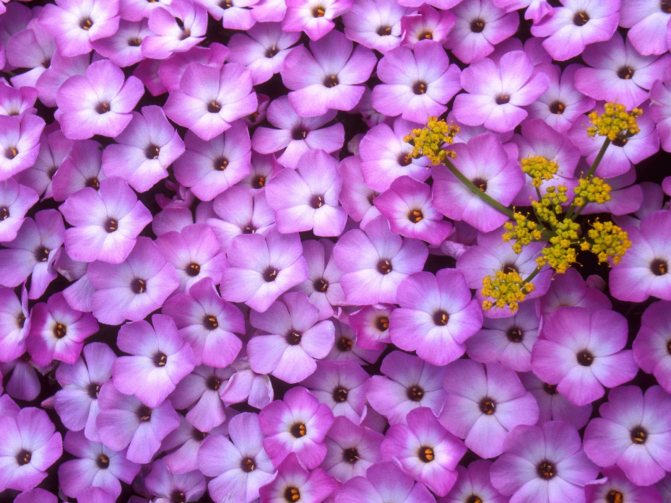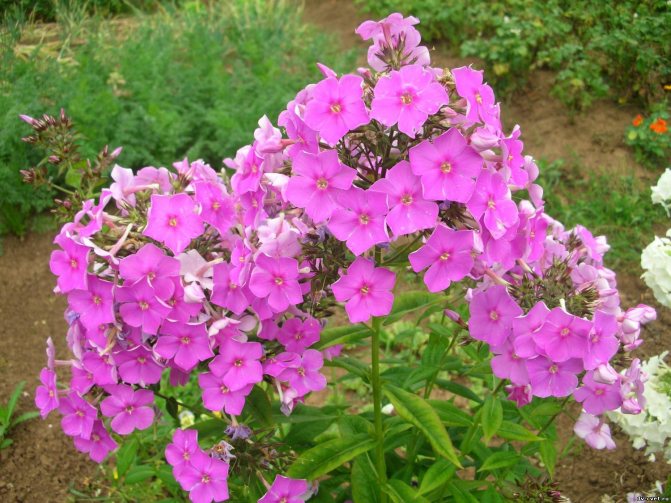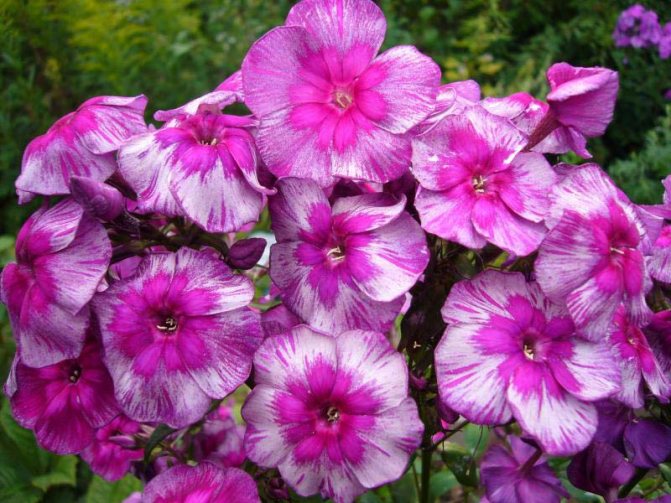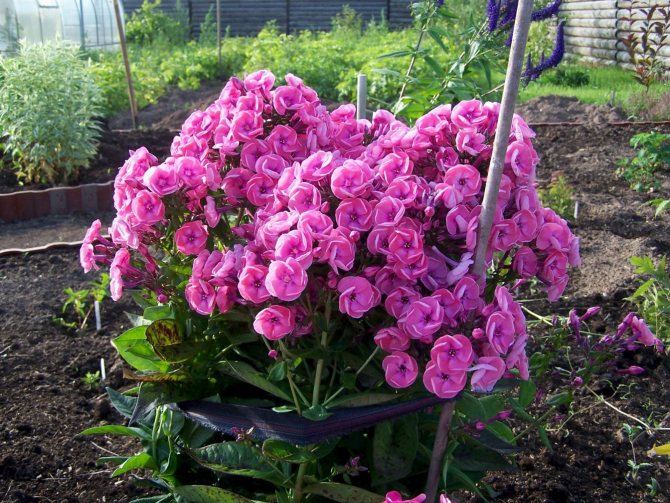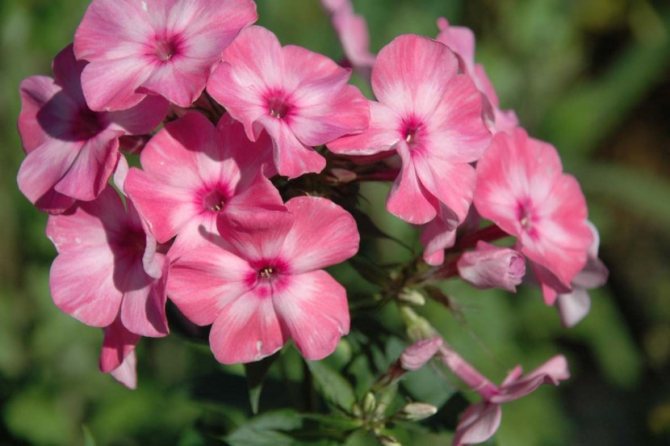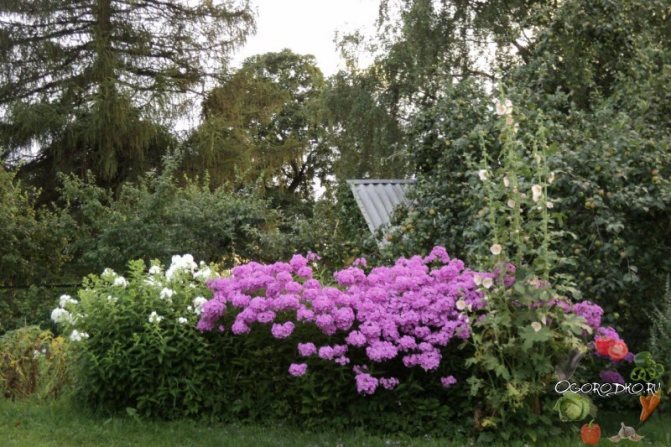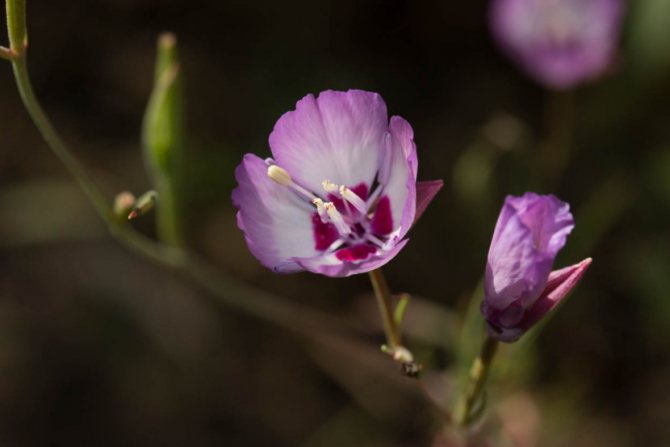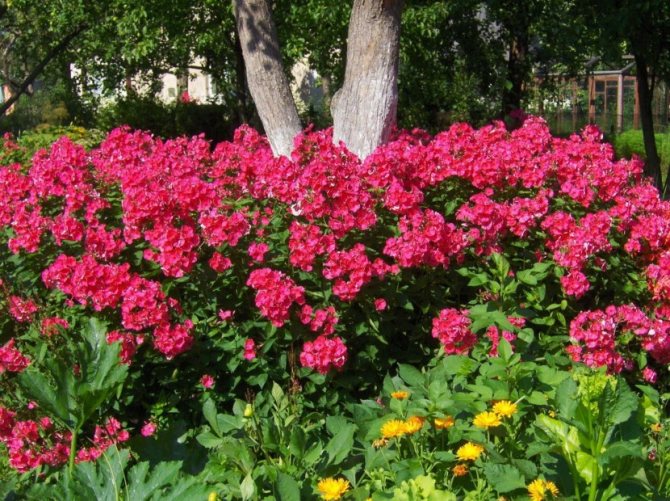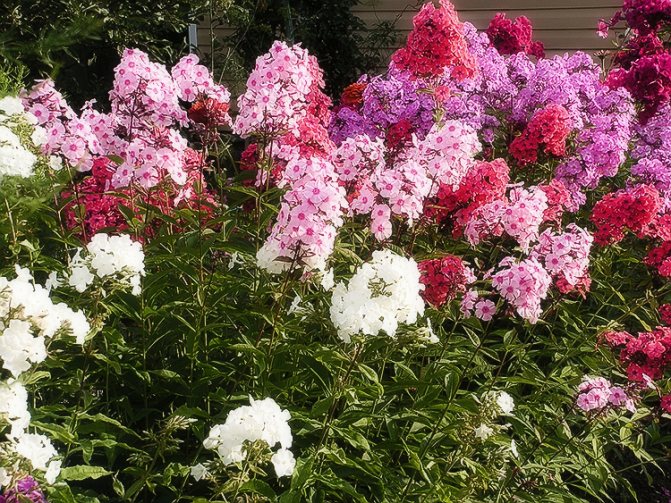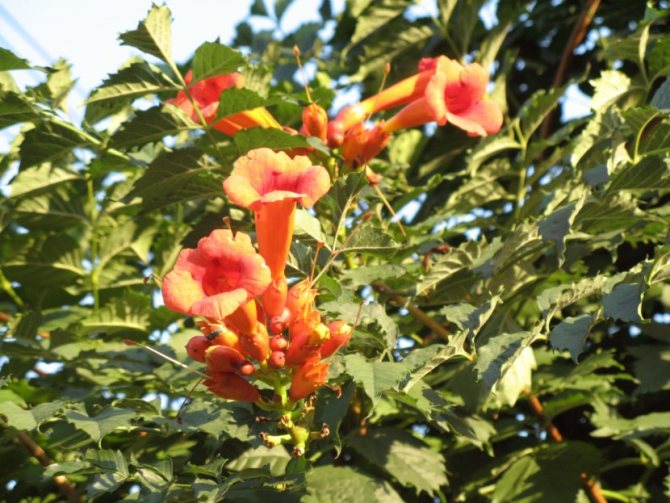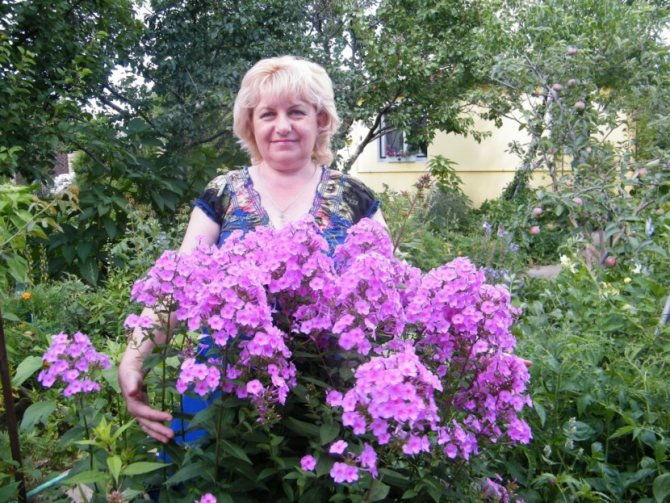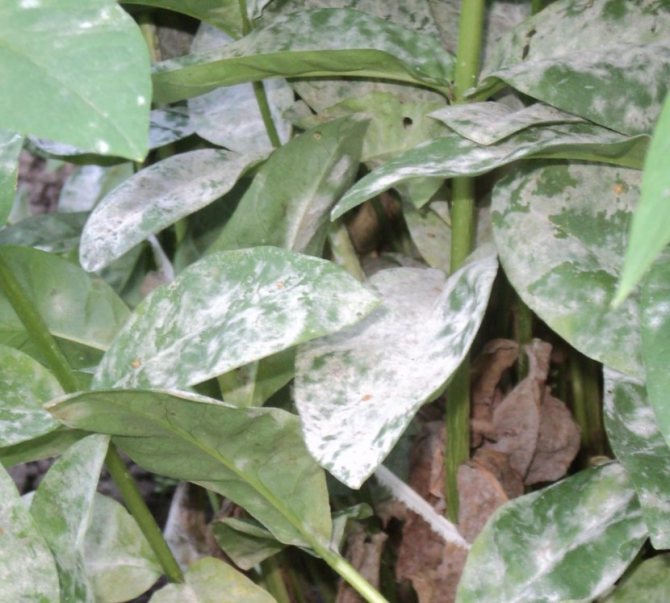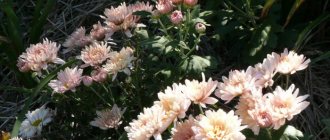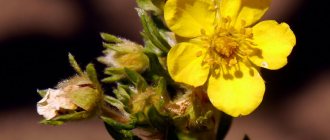
Perennial phlox
Phlox are grown in open, sunny or partially shaded areas, protected from drying winds. You can plant them near buildings, trees and shrubs with a non-superficial root system. A light shade in hot hours is needed for dark-colored varieties, they quickly fade in the sun. Flower beds with phloxes are arranged from the east, west, southwest, southeast.
Choosing a place and soil for planting
The soil should be breathable, nutritious and moist, but without stagnant groundwater. Plants prefer loose loams with acidity close to neutral. Humus, compost, ash and mineral fertilizers must be added to the soil - this is the key to successful growth and beautiful flowering. Coarse river sand, peat are added to the clay soil, acidic soils are lime.
Places for phloxes are prepared in advance. For spring planting - in autumn, for autumn planting - 2 weeks before the earth has time to settle. Since the root system of phlox is powerful, the land is well cultivated. It is dug several times to the depth of the shovel bayonet to make small lumps.
When to transplant phlox
For transplanting phlox, the most favorable period is autumn two to three weeks before the expected frost. By the time of transplantation, the stems of phlox should already be cut off, and the soil is not very hot. A spring transplant is carried out after the snow melts and the ground thaws. In the summer, transplants are carried out by dividing the bush during the entire warm season.
For your information! Flower plants do not need to be grown in the same location for more than six years. Otherwise, various pathogens and pest larvae accumulate in the soil.
Landing
By the time of planting, the land must have a sufficient supply of moisture. If the weather is warm before planting, and it does not rain, then the area immediately before planting is watered abundantly. After drying, the soil is loosened with cultivators by 12-15 cm.
Landing is carried out with one-, two- or three-line ribbons. The distance between the ribbons is 60–80 cm, between the lines in the ribbon 35–50 cm, and between the plants 30–40 cm. When landscaping the territory, phloxes are planted in clumps, but no more than six plants per 1 m2.
When planting, the roots of the rhizomes are straightened, they try to plant the delenka so that, after compaction and subsidence of the soil, the formed eyes are deepened by no more than 4–5 cm. When planting deeper, plants develop worse. With a higher location of the delenka, the base of the developing stem and the vegetative buds forming on it will be at the soil level and damaged by low winter temperatures.
Well-developing spring cuttings are also planted at the same time. Cuttings of the summer harvesting period are planted in a permanent place for the next year.
Diseases
Perennial phloxes can be affected by almost all diseases inherent in other flowering plants. We list the most common types of pathologies.
Fomoz
Signs of this disease are yellowing and curling of foliage, browning and cracking of the stems. To get rid of the misfortune, the bushes are sprayed with Bordeaux liquid four times with an interval of 10 days.
Powdery mildew
A characteristic feature of this common fungal disease is white bloom on foliage.To cope with powdery mildew, you need to use either Bordeaux liquid or other suitable preparations.
And for the purpose of prophylaxis in the spring, it is recommended to spray the shoots with a solution of potassium permanganate.
Watering and moisture
After planting, the plants are watered abundantly, spending at least 15 liters of water per m2 of planting. After the soil subsides and dries up, it is loosened around the planted plants and the plantings are mulched with peat or peat compost in a layer of 4–5 cm.
The first days after planting, carefully monitor the soil moisture. Frequent watering in small doses does not provide constant uniform soil moisture and lead to its compaction. Frequent loosening can damage the plants.
The mulch layer prevents the topsoil from drying out and improves its aeration. If the autumn planting is carried out with a delay, then they are mulched with peat, small shavings and chopped straw. The insulating layer protects the root system from low temperatures in winter.
Timely and correct summer-autumn planting allows plants to root well in the fall. From early spring, the plants start to grow, providing abundant flowering in summer.


Perennial phlox - growing
Description of the plant
In culture, about 40 species of phlox are grown as annual or perennial beautifully flowering herbs and shrubs. They belong to the Polemoniaceae family. The Swedish botanist K. Linnaeus, who was engaged in the 18th century. describing wild flowers, he gave them the Greek name φλόξ, comparing it to a bright flame.


Multicolored phlox
For your information! Phlox flowers can be colored in various shades: from white to purple. Coloring can be monochromatic and with the addition of halftones, strokes, dots, spots.
Flower inflorescences are collected in various configurations - panicles, pyramids, cones. Plants have strong stems, erect, recumbent or ascending, with a height of 30 cm to 1.8 m. Strongly branching roots penetrate deep into the soil. Due to this, perennial phloxes tolerate wintering well in the open field. Some phlox species bloom from early spring, mid-summer phlox blooms, belonging to mid-flowering plants, in August, the turn of late species comes.
Division of bushes
If the division of the bushes in the summer-autumn period is not carried out, then this can be done in the spring. Usually, flower growers resort to this when dividing bushes of especially valuable varieties, since during spring division the bush can be divided into smaller parts. Each divided part may have a single vegetative bud or a shoot that has started to grow and a small number of roots.
At the first time after planting, they especially monitor the uniformity of soil moisture and provide the plants with thorough care. This allows all small planted parts of the rhizome to root normally. By the fall, such plants bloom. True, they not only bloom later, but the developing inflorescences are smaller, and the flowering is less abundant compared to well-developed cuttings planted at normal times in the fall. However, spring plantings are often preferred over belated autumn plantings.
In phlox, the development of the root system and vegetative buds begins early. When the surface of the soil thaws under snow in the spring months, you can already see the developing shoots.
A significant mass of rather thin (2-3 mm), highly branching roots is located in the upper soil layer (from 3 to 15 cm) and does not penetrate deeper than 25 cm. Therefore, it is important for phloxes to preserve spring moisture in the soil, which is facilitated by loosening and cultivation of the site after drying out the soil. At the same time, it also improves the aeration of the soil that has compacted during the autumn-winter period.
More details about the reproduction of phlox by division and cuttings.
How to plant
Ifeion flowers - planting and care in the open field
Planting conditions depend on the climate of the growing site.Phlox are cold-hardy crops, so they are popular in areas with different climates and day lengths. In regions with long cold seasons, phlox are not grown on the northern sides of the plots and in the shade.
In places with a sharply continental climate, early varieties with short growing periods are used for cultivation. In the Urals, for planting and caring for phlox in the open field, the southern hills are taken away, protected from the winds. In the southern regions, slightly shaded places are allocated for phloxes, available for watering and regular maintenance.
Transfer
In one place, without losing decorativeness, phloxes can grow for 4–6 years. They are transplanted more often in spring or autumn, flowering bushes can be planted in summer.
In the Middle Lane, the spring procedure is carried out in late April - early May. By this time, the soil will warm up, thaw and accumulate a lot of moisture, which is very important for phlox. With a spring transplant, plants take root faster in a new place. But there is less time for transplanting in spring than in autumn - only 1–1.5 weeks.
If the transplant is planned for the fall, then it is carried out, focusing on the timing of flowering. By the end of August, renewal buds will appear in early and mid-flowering phlox... Such bushes can be planted throughout September.
For late phlox transplant dates - mid-September - early October. It is not worth replanting later, the plants must have time to take root before the cold weather, so that next year a lush flowering begins.
The bushes are cut into several parts with a sharp shovel and planted in prepared pits so that the buds are in the ground below its level. The optimal distance between plants for low varieties 30-40 cm, for middle-sized - 50 cm. Phloxes more than 1 m high placed at intervals of 60–70 cm.
After transplantation, phloxes are watered abundantly, and in hot weather they are shaded. If the procedure is carried out in the fall, then the seed pods are cut off, and the shoots are partially shortened so that the plant does not waste energy on evaporation.
What you need to know about phlox breeding
Many growers do not classify phlox as plants with which there may be some difficulties in reproduction. After all, these flowers, with an attentive attitude to the matter, can be bred in several ways, and they all give positive results.
Seed propagation
Perennial phlox: planting and care in the open field
This method is used by breeders to grow plants with new characteristics, as there is a change in the color and shape of the inflorescences. Seeds are harvested from ripe fruit pods and in the same year in September-November they are sown in containers, which are dropped in the garden for the winter. During the winter, the seeds undergo stratification (sleep in the cold), germinate in the spring. Seedlings are transplanted into the soil when the plants reach a height of 8-10 cm.
Note! It is necessary to make intervals of 10-15 cm between seedlings.
Dividing the bush
The method of dividing the bush is used either in the spring at the beginning of the development of the bush, or in early autumn. Thus, plants are propagated at the age of 5-6 years, having well-branched large roots. Phlox rhizomes are dug out together with a clod of earth, which will protect the plants from severe damage. Then the ground must be shaken off and carefully separate the root collars going to different stems from each other.


Dividing the bush
Each new part should have eyes, shoot rudiments and several root processes. Separated bushes are best planted in the ground immediately. If this is not possible, then prepare a clay chatterbox. The strips are kept in it for 3-5 minutes. and placed in a plastic bag or sprinkled with damp earth, this will allow the roots to not dry out.


Divided bush
Propagation by cuttings
For the formation of cuttings, shoots without signs of disease, traces of pests, or just phlox leaves are used.Shoots and leaves should be well developed and cut from healthy plants. In the spring, before the beginning of budding, the method of stem cuttings is used; in the summer, propagation is carried out with the help of leaves, which are cut together with the axillary bud on a small piece of the stem. The leaves are planted in moist soil mixed with sand and vermiculite to a depth of 1.5-2 cm. The axillary bud and stem should be in the substrate. The boxes with cuttings are covered with glass, which is lifted and moistened daily.
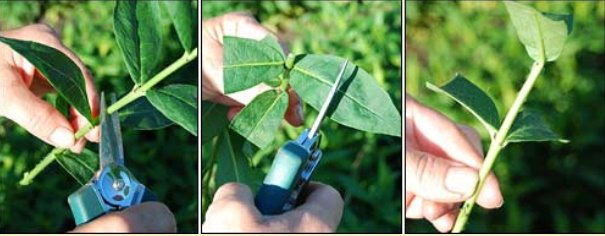

Stem cuttings of phlox
For stem cuttings, green, strong shoots are chosen and only from healthy plants. Shoots are cut into several parts so that each one has four leaves located opposite each other, that is, two nodes. Above the upper leaves, 2 cm of the stem is left, the lower cut is made directly under the knot. The upper leaves are completely removed, the leaves of the lower node are cut in half. The cuttings are rooted in fertile soil. Use seed boxes or open field trenches. Plants create greenhouse conditions.
Reproduction by layering
This method is very simple. It is most often used to grow new perennial phlox. The lower parts of the plant are covered with moistened soil at 1/3 of the height of the bush. The earth is constantly moistened. When roots appear on the stems, the layers are freed from the soil, cut off from the bush and planted in a permanent growing place.


Reproduction by layering
Top dressing and loosening of the soil
Before loosening and cultivation, dry fertilizing with mineral fertilizers is carried out, consuming 20–25 g of ammonium nitrate or 10–12 g of carbamide, 15–20 g of potassium chloride and 15–20 g of superphosphate per 1 m2. The introduction of small doses of potassium-phosphorus fertilizers improves the growth and development of both the vegetative mass and the root system, in particular, increases the number of young overgrowing roots at the base of each stem. When loosening the soil after each watering, try not to damage the young roots, since they are located in the uppermost soil layer (3-4 cm). Regular, all the more abundant feeding without an optimal water supply to plants should not be carried out. Phlox develop better not only on fertile, well-aerated soils, but also necessarily on sufficiently moist.
In second decade of May with intensive development of shoots and leaf apparatus, plants are given liquid organo-mineral fertilizing, consuming 1 liter of mullein infusion or 0.5 liters of chicken droppings, 20–25 g of ammonium nitrate, 15–20 g of potassium and phosphorus fertilizers per 10 liters of water. This amount of solution is used for 1.5–2 m2 of useful planting area.
The same feeding is carried out at the end of May - early June, increasing the dose of potassium-phosphorus fertilizers (up to 30 g of each element).
From the middle june nitrogen on young plantings in top dressing is limited, and when a significant amount of organic matter is introduced during the preparation of the site or with regular mulching, they do not apply. Phosphorus is given 1.5 times more than potassium, dissolving 70–80 g of phosphorus and potassium fertilizers in 10 liters of water. If the weather is dry, the area is watered (¾ norm) before feeding. The rest of the water is given to the plants after feeding.
How to care for phlox
Like all cultivated plants, phloxes cannot do without the active participation of humans in their lives.
How to feed
The first top dressing is necessary in early spring, after winter shelters - foliage, dry grass or artificial protective materials - have been removed from the soil surface. For the growth of stems and the formation of buds, nitrogen fertilizers will be needed: saltpeter, urea or feeding with chicken droppings, mullein. In summer, plants need superphosphate, boron and potassium magnesium for abundant flowering. In autumn, potassium sulfate and phosphorus fertilizers are used.
Important! Mineral dressing is applied on wet soil in the root zone after rain or watering.
Loosening and mulching
The root soil crust, formed after rains and watering, does not allow the roots of the plant to breathe normally, and the cracked earth dries them out. Therefore, you cannot do without loosening the soil when caring for phlox. To simultaneously loosen the soil and remove weeds, flat cutters and hoes are used.
Mulching the root zone in summer allows plant roots not to suffer from overheating and lack of moisture, and the soil does not dry out. Natural and artificial materials are suitable for mulch: cut grass, last year's sawdust, dried bark, decomposed compost without seeds, stone, sand, gravel, special plastic.
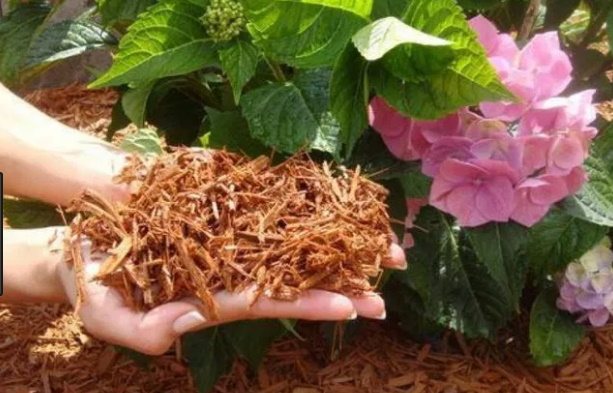

Mulching
Pruning and shaping the crown
For better tillering of phloxes, pinch over the fifth pair of leaves. At this time, the plants should have well-developed stems and at least six leaf nodes. The pinching is carried out before the formation of buds. As a result, lateral shoots grow, the flowering zone increases, the crown of the bushes expands. As flowering proceeds, dried flowers are removed from the inflorescences.
In areas with severe winters, pruning of dying stems in early phlox species begins at the end of August, late varieties are pruned in October-November. The work is carried out with sharp tools so that the stems do not grind. In order not to harm the renewal buds, ten-centimeter stumps are left.
Important! In the southern regions, the stems of plants are not removed for the winter; pruning is carried out in the spring.
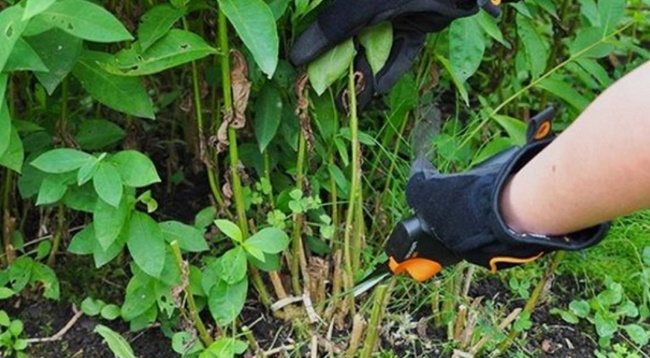

Pruning stems
Watering
The powerful root system of phlox is able to raise a lot of moisture to the tops of plants, but it is necessary that this moisture be in the soil. The need for watering and their intensity are determined by the appearance of the plant: with a lack of moisture, the lower parts of the stems turn pale, the leaves turn yellow and die off, the inflorescences become smaller. When the soil dries up per 1 m², up to two buckets of water are used; it is necessary that the moisture soaks the ground to the layer where the roots are located.
Wintering and shelter
In cold climates and in those places where there is little snow in winter, but frosts are fierce, cut bushes of plants are covered with dry peat and fallen leaves. The thickness of the shelter is up to 10 cm. In the spring, the protection is removed. Where phloxes are not pruned in autumn, snow accumulates in the bushes and becomes an additional protection for plants.
Thinning
Suppose the selection has been successfully carried out, the remaining healthy ones grow beautifully. Now thickened plantings should be avoided, for which it is necessary to remove excess stems and leaves in a timely manner, plantings should be very well ventilated and receive enough light and moisture.
In the spring, when shoots grow back up to 5-7 cm, they are normalized, breaking out the excess, weakened ones. Powerful peripheral shoots are better provided with water and food. The stems of the central part of the bush develop worse, become smaller.
When breaking off the shoots, try not to damage the base of the root collar, which leads to the death of a part of the rhizome. This allows you to grow the most ornamental plants with large inflorescences and juicy flowers.
Florists often pinch some of the shoots in May. This extends the flowering of the bush by 4-5 weeks. On a pinched stem, 2-3 shoots develop. Each such stem has smaller inflorescences, but together they have a very beautiful appearance. By pinching all the shoots, you can postpone the flowering time of the bush to the end of August.
Description and characteristics of perennial phlox
The plant is a bush with straight stems and oval leaves. The height of the plant, depending on the species, ranges from 10 to 150 cm.
The stem ends in an inflorescence, which can contain up to 90 flowers. A tubular flower has five petals. The colors are varied, mainly pink, purple, blue shades are popular.


Phlox color variety
After flowering, seed pods are formed.
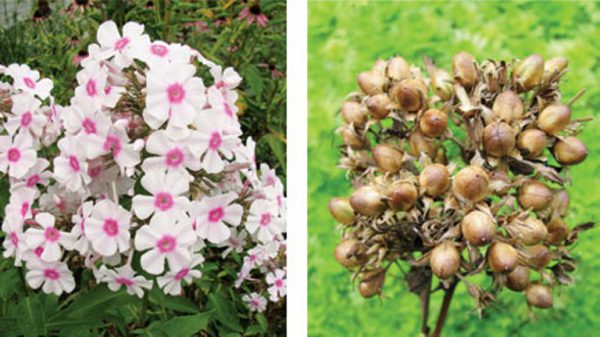

Mother plant and ripe seed pods
Pest and disease control


Phlox perennial grade Early Light Pink
Phloxes are infected with viruses (annular and necrotic spotting, rattle and curly leaves, variegated flowers), fungal diseases (powdery mildew, phomosis, rust and leaf spot).
Mycoplasmas cause disease jaundice... It manifests itself in deformation of shoots, growth retardation.
Plants infected with viruses or mycoplasmas are destroyed. Fight against fungal infection with the help of copper preparations.
When growing phlox on acidic soils and improper watering, cracks may appear on the stems, leaves dry and fall off.
Phlox get damaged nematodes, caterpillars, slugs, slobbering penny.
In places of congestion leaf and stem nematodes swelling appears, plants are bent, stunted. The larvae of worms are tenacious and do not die during wintering. Sick phloxes are destroyed, the soil is treated with special preparations.
Slobbering penny feeds on plant sap, leaving a white discharge on the underside of the leaves. The drug "Inta-vir" helps against it.
In rainy weather slugs eat leaves, buds of phlox. They destroy pests by arranging baits, sprinkling the paths with lime, metaldehyde.
Caterpillars of butterflies eat delicate leaves and flowers. They are disposed of with insecticides.
Folk remedies for diseases and pests
And here is the well-known folk remedies for the healing of phlox.
- In the spring, as soon as sprouts appear, they are abundantly sprinkled with ash. When the sprouts reach 15–20 cm, they are sprayed with a copper-soap solution. To do this, dilute 20 g of copper sulfate in 12 liters of water. Separately dissolve one piece of laundry soap in 9 liters of hot ox. After cooling, the first solution is poured into the second with constant stirring. Strain before use. If necessary, the treatment is repeated after two weeks.
- Another old and reliable remedy is the treatment of phlox bushes in the fall with a 1% solution of soda ash. For better settling on plants, laundry soap is added to the solution. Some gardeners add laundry detergent instead.
- And in conclusion - a little about the nematode. This is such a worm invisible to the naked eye that feeds on the juice of stems and leaves. In places where nematodes accumulate under the skin of the stem, swelling is clearly visible. When damaged, the shoots are bent, gradually the whole plant is deformed and dies. Sadly, but the best way to deal with a nematode is to destroy the diseased bush along with a lump of earth. For the prevention of nematodes in the fall, the earth should be shed with ammonia (a bottle on a bucket of oxen), and in May, the procedure should be repeated. Not radical, but better than nothing. Such a remedy is also known: add 1 liter of urine to a bucket of water. It is believed that this is prevention against nematodes, and top dressing, and an increase in plant immunity.
Disease prevention


Phlox paniculata
Phloxes suffer from viral and fungal diseases, all diseases lead to various changes in the color and shape of stems and leaves. In flowers, as in humans, prevention is the best control measure. Regular inspection of plantings allows you to detect diseases at an early stage. Phlox reproduce well, so it is more advisable to part with a couple of suspicious bushes than to endanger all plants. Serious collectors, of course, will fight for rare varieties to the bitter end. For lovers, it will not be difficult to fill their garden with phloxes, which are distinguished by excellent health and practically do not get sick. If there are a dozen or two phlox in the collection, it is not difficult to choose the healthiest of them, thereby facilitating care and preserving other plants.
Phlox in landscape design
Since phlox are unpretentious plants, they can be planted in a variety of places, regardless of the type of soil. Even if there is no piece of land, you can plant flowers in a container.If there is land, you can give free rein to imagination and build many flower beds with phloxes.
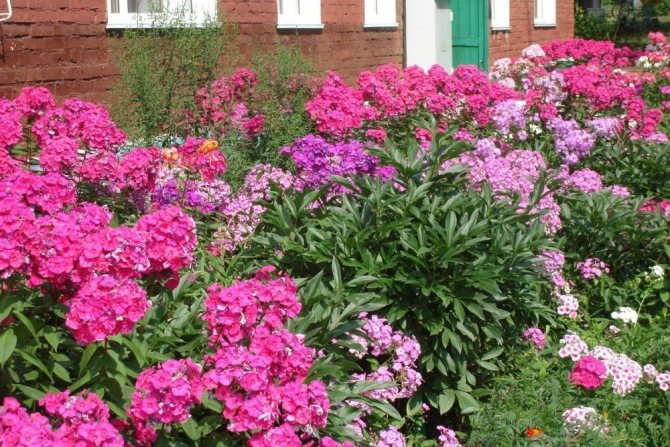

Flowerbed with phlox
With certain knowledge in the field of landscape design, with the help of phlox, you can create various compositions that will differ in harmony in color and location in space.
Note! Experts recommend planting phloxes in a flower bed in a large array, placing them taking into account the height of adult plants, the time of their flowering, as well as the nuances of the combination of inflorescences and foliage.
Plain flowers are best suited for decorating parks and large areas, as they look most advantageous from a long distance. For those who like to enjoy the beauty of flowers in the early morning or evening, varieties with white flowers or chameleons that change their color are best suited.
Possible varieties
It should be noted that it is very difficult to classify flowers of this type. Among the methods proposed by breeders, the most understandable and often used is this:


Types of phlox
There are also early and winter-hardy varieties, differing in the timing of flowering. Often, varieties are divided by color: white, blue, pink, red, orange. Gardeners most often pay attention to annual and perennial varieties when choosing places for planting. Among them, the following varieties can be distinguished:
| Annuals | Perennials |
| Rayonnant; | "Svyatogor"; |
| "Panama"; | "Russian beauty"; |
| Miss Ely; | "Pink Rayonant"; |
| Miss Pepper; | "Blue joy"; |
| Silberlachs; | "Cinderella"; |
| Madame Doctor Charcot; | Girl's Blush; |
| Salmon Glow. | "Pink Tale". |
Interesting features
Phlox translates to "flame," which is why phloxes are often referred to as fire flowers. The homeland of these plants is North America, but they have taken root in Europe for a long time - since the seventeenth century. To date, more than seventy species and about one and a half thousand varieties of perennial phlox are known - the florist, indeed, has plenty to choose from.
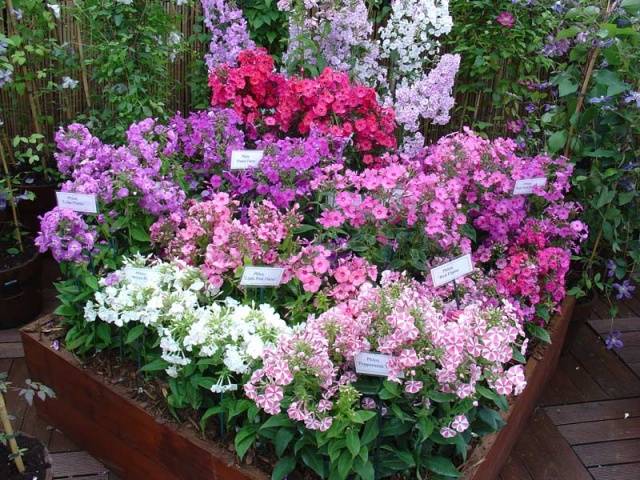

The fire flower is actively used by landscape designers, as it is suitable for decorating a garden and local area in any style. True connoisseurs of ornamental plants love phlox for their variety: there are inflorescences of absolutely any shades, varieties with different flowering periods and different heights of the bush.
Attention! There are so many varieties of phlox that it is quite possible to create a flower garden from these plants alone: a well-designed flower bed will bloom from early summer to late autumn. Such flower beds are called phloxaria.


Perennial phloxes have taken root in Russia due to their unique winter hardiness - they are one of the few flowers that can withstand severe frosts without shelter.
Phlox after flowering
Annual phloxes may bloom next year, but the quality of the inflorescences is unlikely to be high. Therefore, collect, if you like, seeds, cut off the tops that have dried up in the fall, and dig up the ground on the site, removing phlox rhizomes from it. In the spring you can sow the collected seeds, and the flowers you like will bloom again.
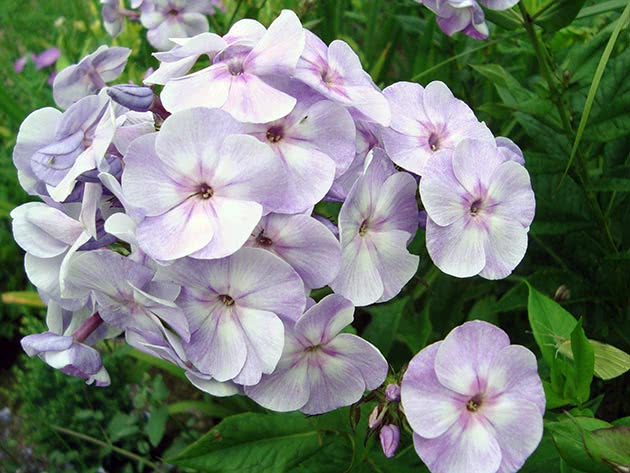

Photo: Blooming phlox in the garden
Phlox wintering
Perennial phlox, or rather, their growth buds in a snowless winter can freeze out if the temperature drops to -10-15 ºC, and if the frost reaches -20-25 ºC, the phlox rhizome will die. Therefore, in the fall, after the phlox tops have turned yellow and dried, cut it off, and sprinkle the root collars with a layer of soil with peat. Cover them with straw, fallen leaves, or spruce branches to keep the roots in the soil until spring. If snow falls 50-60 cm thick, then you can not be afraid of thirty-degree frosts.
Types and varieties of plants
Phlox numbers about 85 varieties, half of which are cultural and decorative.Under natural conditions, most species grow in North America, and on the territory of our country, only Siberian phlox can be found in the wild.
The most popular annual plant is the Drummond phlox, named after the Scottish botanist who brought the flower to England. It is well cultivated, has many varieties with various corolla colors.
Now let's look at the most popular perennial phlox varieties with a photo and a name among flower growers.
Phlox paniculata
The most common type of phlox, which is found in almost every garden. It begins to bloom in early summer and pleases with flowers all season. He has very large inflorescences of a wide variety of shades, including "spotted" multicolored flowers. But this species does not have yellow colors.
The shrub is quite large, reaching a height of half a meter to a meter and even higher. At the ends of the densely leafy shoots, of which there are more than twenty, lush "candles" of inflorescences bloom. They are very fragrant and bright, do not fade in the bright sun and are not afraid of shading.
This species prefers well-drained soil, moderate watering and good air circulation. They are not recommended to be planted close to buildings that protect against drafts, and in no case are mulched in the summer.
Varieties and hybrids:
- Amethyst - has bluish-purple petals, blooms in July-August;
- Blue Paradise - flowers of a lavender shade with a blue center, smells very nice, blooms at the end of summer, reaches a height of 1 m 20 cm;
- Bright Eyes - pale pink flowers with a bright core, a very unpretentious variety, resistant to fungal infections;
- "David" - a titled variety with an award from English flower growers has very lush snow-white inflorescences, is absolutely not capricious and never gets sick;
- Delilah - bright pink, almost purple flowers form neat inflorescences, bloom in July-September;
- Candy Twist - bicolor striped flowers of white and pink hue, smells good, does not fade in the sun and is resistant to disease;
- "Sandro Botticelli" - bred by a Russian breeder and worthy of the brush of the famous artist, has purple and pink petals.
Phlox subulate
A dwarf species with low ten to fifteen centimeter shoots. Its second name is sod phlox. Each stem produces many side branches, the plant grows well and covers the entire garden with a flowering carpet.
The inflorescences are small, consist of several flowers - no more than four, but are located very densely, behind them leaves are practically not visible. True, the leaves are small, like needles. They are leathery and dense to the touch.
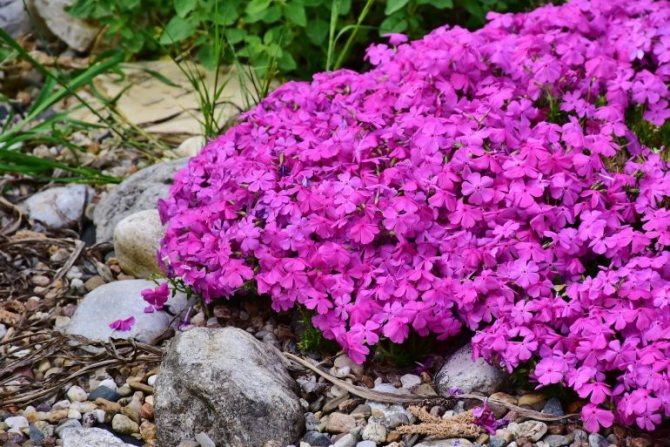

Photo: https://enn.imadeself.com/photos/phlox-plant-pink-polemoniaceae-3398370/ The colors are delicate, pastel - light lilac or mauve. Flowering begins early, in late spring.
This type is widely used in landscape design. The plant tolerates a "haircut" well and it is possible to form compositions with various geometric shapes from it.
Varieties and hybrids:
- Bonita - the flowers are bright pink with a purple eye. This hybrid is not afraid of either heat or frost;
- Candy Stripes - very motley, on a white background, a wide bright pink stripe, and the middle is dark purple;
- Early Spring Blue - lavender-blue flowers bloom in April and cover the ground with a dense carpet.
Splayed phlox
Its second name is Canadian. The shrub is medium-sized, reaching a height of forty to fifty centimeters. It has very large flowers of a white or bluish-lilac hue. Inflorescences are umbellate, their diameter can exceed ten centimeters. Flowering begins in late spring or early summer.
This species does not like peaty and deciduous soil, prefers light soil with the addition of humus.In order for him to feel good, he does not need to be fed with manure or peat.
Varieties and hybrids:
- Clouds of Perfume - a soddy undersized bush that forms a rug of lavender flowers. Blooms in April or May. With insufficient care, it can suffer from powdery mildew and nematodes;
- "Landen Grove" (London Grove) - from a distance resembles a scattering of forget-me-nots. Unpretentious, resistant to diseases, grows well;
- Fuller's White - has white petals with a slightly lilac tint. It is very frost-resistant, it is not afraid of frosts down to -40 ° C.
- Eco Texas Purple - corollas are dark purple, with a pink eye. They bloom relatively late - in June.
Wintering
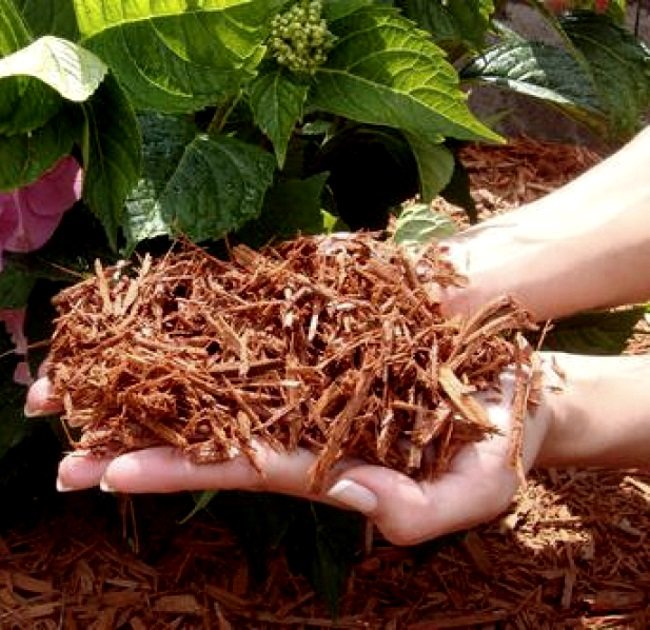

Perennial varieties after flowering must be cut off, leaving up to 15 cm of the bush. All fallen leaves and petals should be collected, as they are susceptible to disease infection. The root part of the flower is covered with straw, spruce branches or peat, and the cut stem must be covered with burlap or agrofibre. Be sure to leave small holes for ventilation.
Care in the garden from the moment of planting in the open ground
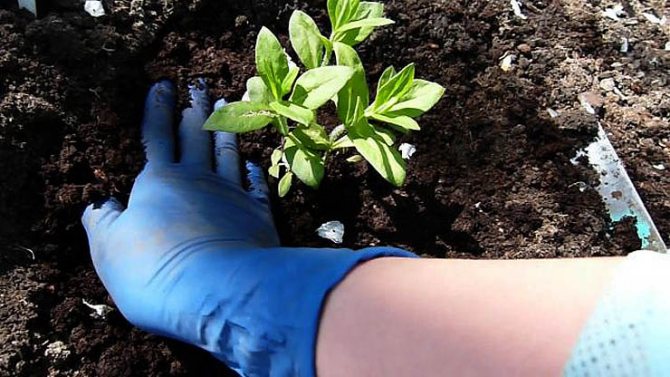

Phloxes require regular watering, therefore, such flowers are not suitable for lazy summer residents.
Young plants should be the subject of constant care of the grower. Regular watering is needed, but waterlogging of the soil should not be allowed - excessive dampness often causes fungal diseases. 2-3 treatments of plants with a solution containing growth stimulants will be useful. Of the fertilizers, preference is given to nitrogenous compounds - they help the flower to gain green mass as soon as possible.
Weeding is necessary so that weeds do not take away nutrients, water and sunlight from young plants. Weed removal should be combined with loosening, since light, air-saturated soil is a priority for phlox.
In case of sudden changes in weather conditions, phloxes may need protection in the form of some kind of covering material.
How to care during growth and flowering
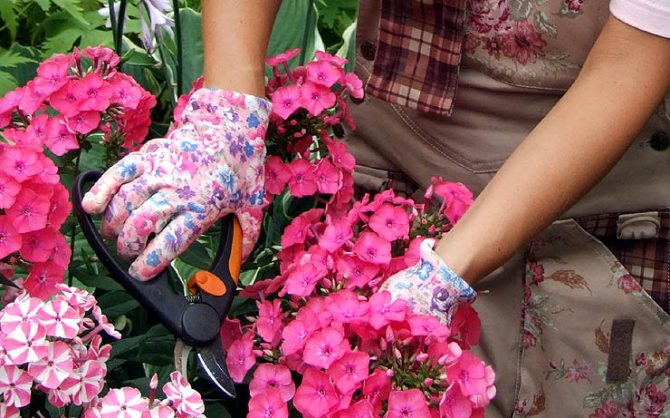

So that the phlox stems do not interfere with each other, they should be thinned out, leaving the strongest
Lush bloom of phlox is impossible without regular generous watering (1 bucket of water per 1 sq. M.), At least in 4–5 days. In addition, fertilizing with fertilizers intended for flowering crops is mandatory. It is necessary to very accurately observe the dosage indicated on the packages, since if the norm is exceeded, the nitrogen contained in the fertilizers has a positive effect on the foliage, and the flowering will be modest. By the end of summer, you need to focus on fertilizers with potassium - such feeding will help phlox bloom longer, and their inflorescences will become brighter.
Since phlox have been grown in Russian gardens for a very long time, a folk recipe that has stood the test of time will be appropriate. In order for the plants to bloom magnificently, you need to take 100 g of rye bread, soak it in 1 liter of water, leave for a day, and then use it for root watering.
To preserve the decorative effect, faded brushes should be regularly removed. And you also need to prune excess shoots from time to time so that the shape of the bush is better, and the flowering lasts longer.
Advice
- Do not remove the buds immediately after flowering. The formed pods can be used to plant phloxes in the next season.
- Perennial varieties can be grafted throughout the summer, they take root quickly and grow well in a new place.
- In a climate of the south or temperate latitudes, planting is possible in autumn, spring and even summer.
- In order to avoid the appearance of slugs and caterpillars, it is recommended to process the planting twice a season with a mixture of tobacco dust and wood ash.
- After pruning in the fall, the leaves must be harvested and burned to avoid the development of fungal infections and pests, which are usually activated in the spring.
Phlox are truly versatile flowers.Due to the large number of varieties of this plant, you can choose any shape and height of the flower. With proper care, they will become a decoration of the site, without requiring complex procedures. Suitable even for beginners, ways to bloom and develop in almost any conditions.
Color problems
Improper care can lead to some growing difficulties.
| Problem | Cause |
| The stem is cracked and the leaves dry out at the bottom of the branches. | Wrong water, light and temperature conditions. For example, a flower was watered with cold water or during a drought it did not receive enough moisture. |
| The upper leaves are green and healthy, while the lower leaves fall off or dry out. | Insufficient watering. |
| The bush degenerates and gradually dies off. | It is necessary to plant and rejuvenate the bush by dividing. This procedure is done every five to seven years. |
| The shoots are too tall, and the inflorescences are "thin". | Wrongly chosen landing site - lack of sunlight. |
| Phloxes do not bloom. | There are two main reasons - too much shade and heavy wet soil. |
Stallion phlox - photo
These are unpretentious plants that, thanks to the stolons rooting in the nodes, develop very quickly. They have a thick rhizome, and their stems grow so that even weeds do not germinate through them. They take root literally from one contact with the ground. As a result, new peduncles grow, and dense, beautiful carpet... They should be planted in fertile, moist soils and shady areas.
The most popular varieties are:
- The Blue Ridge variety grows up to 25 cm and blooms with purple-blue flowers with a yellow stamen. Prefers to grow in loose soil and semi-shady areas. Loves abundant watering.
- Variety "Purpurea" grows well in partial shade. Its peduncles reach 25 cm in length and consist of pale pink flowers with yellow stamens.
- The Fuller's White variety is a flexible, creeping plant, the height of which is about 30 cm. It blooms for a long time with white flowers without any extraneous impurities and shades. Suitable for the formation of an alpine slide and wall decoration. Suitable for cutting.
- Violet Queen grows up to 40 cm and blooms with blue flowers with a lilac tint. Flowering lasts no more than thirty days, after which the peduncles are cut off. Suitable for cutting.
Autumn pruning
Many novice gardeners are wondering whether phlox should be pruned for the winter? If we are talking about a long-term crop, experts recommend preparing it for winter correctly and pruning it. You can watch the video for how to do this.
Pruning for the winter is carried out in the fall, when flowering ends, from about September 20 to October 31, after the accumulated nutrients have passed from the green part of the plants to the rhizome. The work should be completed before the onset of persistent cold weather.


For example, in the southern regions and in the Kuban, pruning can be carried out a little later. Take into account the climatic features of the growing region, but be sure to wait until the plant has bloomed, only then proceed with the surgical intervention.
Pruning for the winter is carried out when it gets colder outside. Many growers leave small stumps (10-15 cm), some completely cut off the stem, almost level with the ground.
The experience of seasoned gardeners shows that complete pruning reduces the risk of disease and the spread of infections. After cutting, it is recommended to treat the soil around it with fungicidal preparations. After a week, the space is sprinkled with wood ash, then mulched with peat chips.
Best subulate phlox
Bavaria
Rating: 4.9
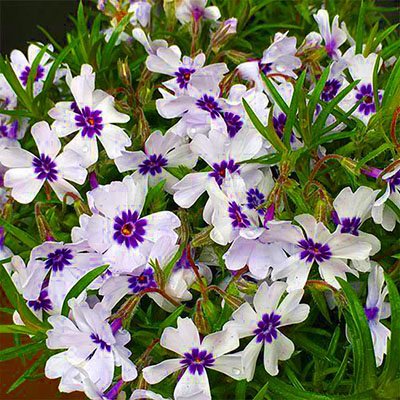

One of the most beautiful phlox species, it blooms from May to June and from August to September. The first bloom is usually more lush than the second. Among other varieties, the flowers are distinguished by snow-white petals, diluted with purple cilia at the base. For this unusual combination, our experts included Bavaria in the rating of the best phlox varieties.
The plant can grow up to 17 cm high. Each stem ends with a peduncle with one or two flowers. Their color is usually pink, white, purple. Gardeners love to plant phlox Bavaria on stone terraces and between slabs of garden paths. The plant prefers dry, loose soil. The minimum cost of a Bavaria seedling is 170 rubles.
Dignity
- bloom 2 times a year;
- unusual color;
- bush diameter - 50 cm;
- flowers with a diameter of 25 mm;
disadvantages
- cannot stand lack of moisture.
Bonita
Rating: 4.8


A popular plant species made it to our ranking of the best phlox due to its unprecedented resistance to severe temperature changes. The flower calmly tolerates both heat and severe frosts. Their bloom is always observed in July-August. It does not depend on weather conditions and temperature jumps.
Customers praise Bonita's phloxes for their lovely bright pink flowers. They note that their presence in the garden is very pleasing to the eye and uplifting. Gardeners believe that the best place to plant this species is along the garden path. There flowers and feel good and look harmonious. You can buy a seedling for 80 rubles.
Dignity
- not afraid of low temperatures;
- stable flowering;
- looks like a flower carpet;
- height - 45-62 cm.
disadvantages
- not detected.
Red wings
Rating: 4.7
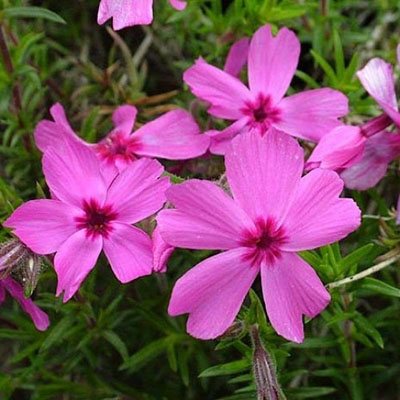

The dark green foliage of Red Wings resembles needles intertwined. The flowers are pink in color with dark red elements in the center. We have selected the variety in the ranking of the best phlox for its versatility. These flowers look great both in a group planting and in a single plant. Experienced gardeners prefer to plant the view on rocky flower beds and slopes.
Phloxes of this variety thrive best in loose soil. However, it should not be too fertile and moist. Flowers like a hill where water will not accumulate. Red Wings usually bloom in May-June. According to customer reviews, this is one of the most beautiful flowers. You can buy a plant at a price of 340 rubles.
Dignity
- dense beautiful foliage;
- drought-resistant;
- withstands cold;
- beautiful bloom;
- the height of the bush is 11-16 cm.
disadvantages
- very picky about lighting.
Violet Pinwills
Rating: 4.6
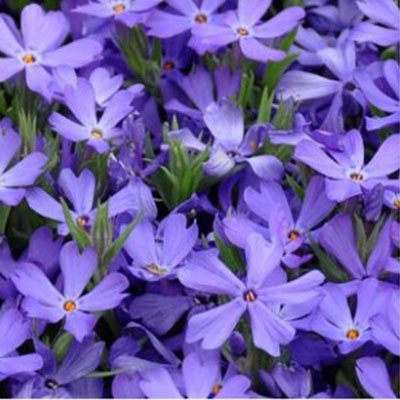

The variety was included in our rating due to the unusual shape of the petals. They resemble the blades of a turntable and have a purple-violet gradient color. The height of the bush can reach 16 cm.Flowering usually occurs in the second half of May
The pronounced aroma spreads over several meters and creates an inviting atmosphere around itself. Buyers love the way the plant covers the area in the form of a colored carpet. We consider the flower to be the best option for those who like it brighter and more aromatic. The minimum cost of a plant is 195 rubles.
Dignity
- beautiful thin petals;
- nice smell;
- grow tightly to each other;
- flowers retain their shape for a long time.
disadvantages
- does not tolerate too wet soil.
Atropurpurea
Rating: 4.5
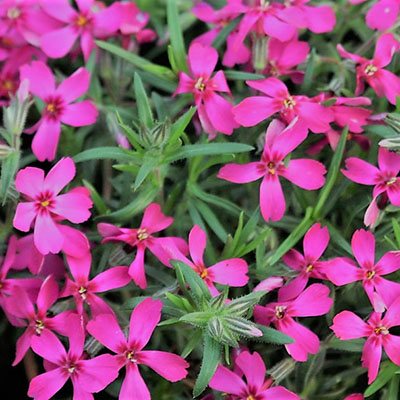

The flower belongs to creeping phlox. Among its congeners, the variety stands out for its purple-pink matte flowers. It is impossible not to notice him in the garden. The magical coloring attracts the eye and gives an unforgettable aesthetic pleasure. It is possible to admire the flowering during the period May-June (mid-month).
Atropurpurea is liked by buyers for the bright contrast of the yellow center with juicy leaves. The plant can survive in the shade, but will not please the owners with lush flowering. The flower belongs to the oldest garden forms and to this day enjoys justified popularity among gardeners. The price of this phlox is 170 rubles.
Dignity
- bush diameter - 51 cm;
- does not die in the shade;
- rarely suffers from diseases;
- not attractive to pests;
- unpretentious to care for.
disadvantages
- picky about the looseness of the soil;
- needs regular fertilization.
Drummond annual phlox (Phlox drummondii)
Phloxes of this species are grown from seeds.There are two ways, directly landing in the ground (May), when the soil warms up. Or with the help of pre-grown seedlings.
Drummond characteristics:
- height up to 30 cm;
- characteristic flower shape, with pointed edges;
- flowering period is three months from summer to frost;
- used for rockeries, flower beds, alpine slides;
- planted in lighted places;
- flowers have a delicate aroma.
Variety of varieties in the photo:


Seeds are sold in mixes and individual varieties.
Culture care
Caring for perennial phloxes in the fall is as follows:
- Regular watering of flowers. Moreover, the culture does not like both an excess of moisture and its lack. The main indicator of full-fledged irrigation is constantly moderately moist soil. Moreover, you need to water the flowers directly under the root, trying not to get on the leaves and stems. If the August heat is still on the street, then you need to moisten the soil around the phloxes in the morning and in the evening.
- It is imperative to periodically loosen the ground around the flowers. Such measures improve the drainage capacity of the soil.
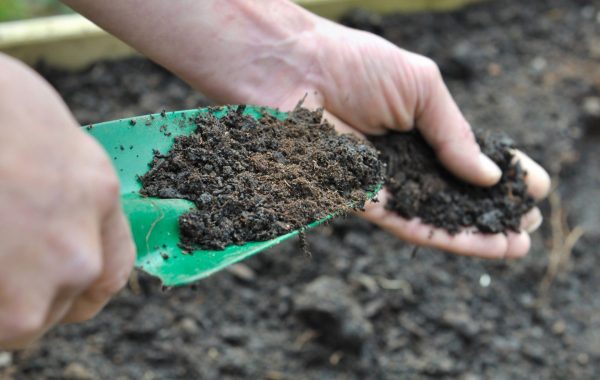

As for autumn dressings, it is better to use phosphorus-containing or potassium complexes for phlox. All liquid dressings are applied under the bush only after watering it.
For the winter, young seedlings must be covered. This will protect the root system of the flower in the snowy and cold winter.
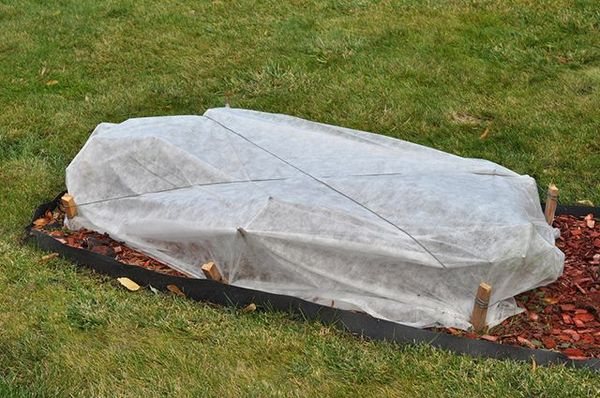

Rating of the best varieties of phlox
| Nomination | a place | grade | rating |
| Best subulate phlox | 1 | Bavaria | 4.9 |
| 2 | Bonita | 4.8 | |
| 3 | Red wings | 4.7 | |
| 4 | Violet Pinwills | 4.6 | |
| 5 | Atropurpurea | 4.5 | |
| The best popular phlox varieties | 1 | Zenobia | 4.9 |
| 2 | Victoria | 4.8 | |
| 3 | Creme de la Creme | 4.7 | |
| 4 | Boutonik | 4.6 | |
| 5 | Starfire | 4.5 | |
| 6 | Katarina | 4.4 | |
| 7 | Larissa | 4.3 | |
| 8 | White sparr | 4.2 | |
| 9 | Nikki | 4.1 | |
| 10 | Delilah | 4.0 |



